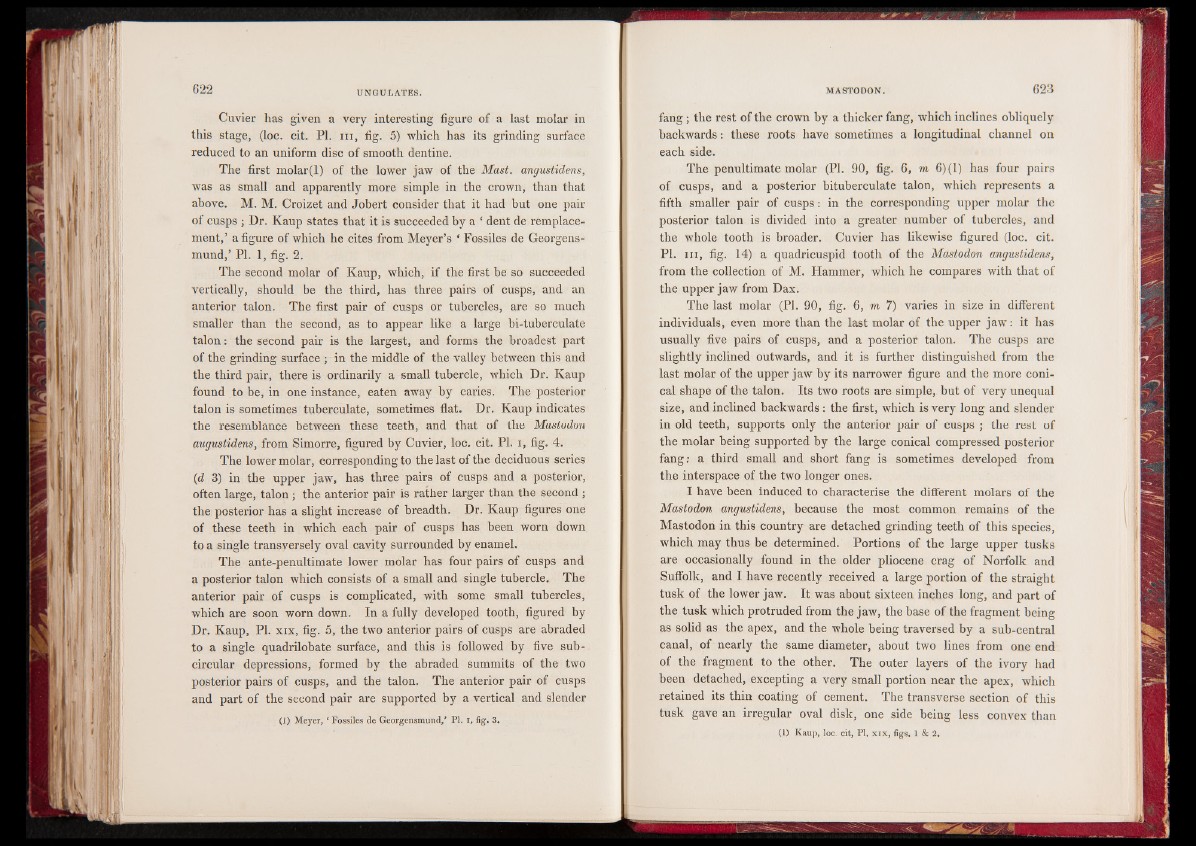
Cuvier has given a very interesting figure of a last molar in
this stage, (loc. cit. PI. h i , fig. 5) which has its grinding surface
reduced to an uniform disc of smooth dentine.
The first molar(l) of the lower jaw of the Mast, angustidens,
was as small and apparently more simple in the crown, than that
above. M. M. Croizet and Jobert consider that it had but one pair
of cusps ; Dr. Kaup states that it is succeeded by a ‘ dent de remplace-
ment,’ a figure of which he cites from Meyer’s ‘ Fossiles de Georgens-
mund,’ PI. 1, fig. 2.
The second molar of Kaup, which, if the first be so succeeded
vertically, should be the third, has three pairs of cusps, and an
anterior talon. The first pair of cusps or tubercles, are so much
smaller than the second, as to appear like a large bi-tuberculate
talon: the second pair is the largest, and forms the broadest part
of the grinding surface ; in the middle of the valley between this and
the third pair, there is ordinarily a small tubercle, which Dr. Kaup
found to be, in one instance, eaten away by caries. The posterior
talon is sometimes tuberculate, sometimes flat. Dr. Kaup indicates
the resemblance between these teeth, and that of the Mastodon
augustidens, from Simorre, figured by Cuvier, loc. cit. PI. i, fig. 4.
The lower molar, corresponding to the last of the deciduous series
(d 3) in the upper jaw, has three pairs of cusps and a posterior,
often large, talon ; the anterior pair is rather larger than the second ;
the posterior has a slight increase of breadth. Dr. Kaup figures one
of these teeth in which each pair of cusps has been worn down
to a single transversely oval cavity surrounded by enamel.
The ante-penultimate lower molar has four pairs of cusps and
a posterior talon which consists of a small and single tubercle. The
anterior pair of cusps is complicated, with some small tubercles,
which are soon worn down. In a fully developed tooth, figured by
Dr. Kaup, PI. xix, fig. 5, the two anterior pairs of cusps are abraded
to a single quadrilobate surface, and this is followed by five sub-
circular depressions, formed by the abraded summits of the two
posterior pairs of cusps, and the talon. The anterior pair of cusps
and part of the second pair are supported by a vertical and slender
(i) Meyer, ‘ Fossiles de Georgensmund,’ PI. I, fig. 3.
fang; the rest of the crown by a thicker fang, which inclines obliquely
backwards: these roots have sometimes a longitudinal channel on
each side.
The penultimate molar (PI. 90, fig. 6 , m 6)(1) has four pairs
of cusps, and a posterior bituberculate talon, which represents a
fifth smaller pair of cusps: in the corresponding upper molar the
posterior talon is divided into a greater number of tubercles, and
the whole tooth is broader. Cuvier has likewise figured (loc. cit.
PI. ni, fig. 14) a quadricuspid tooth of the Mastodon angustidens,
from the collection of M. Hammer, which he compares with that of
the upper jaw from Dax.
The last molar (PI. 90, fig. 6, m 7) varies in size in different
individuals, even more than the last molar of the upper jaw : it has
usually five pairs of cusps, and a posterior talon. The cusps are
slightly inclined outwards, and it is further distinguished from the
last molar of the upper jaw by its narrower figure and the more conical
shape of the talon. Its two roots are simple, but of very unequal
size, and inclined backwards : the first, which is very long and slender
in old teeth, supports only the anterior pair of cusps ; the rest of
the molar being supported by the large conical compressed posterior
fang; a third small and short fang is sometimes developed from
the interspace of the two longer ones.
I have been induced to characterise the different molars of the
Mastodon angustidens, because the most common remains of the
Mastodon in this country are detached grinding teeth of this species,
which may thus be determined. Portions of the large upper tusks
are occasionally found in the older pliocene crag of Norfolk and
Suffolk, and I have recently received a large portion of the straight
tusk of the lower jaw. It was about sixteen inches long, and part of
the tusk which protruded from the jaw, the base of the fragment being
as solid as the apex, and the whole being traversed by a sub-central
canal, of nearly the same diameter, about two lines from one end
of the fragment to the other. The outer layers of the ivory had
been detached, excepting a very small portion near the apex, which
retained its thin coating of cement. The transverse section of this
tusk gave an irregular oval disk, one side being less convex than
(1) Kaup, loc. cit, PI. xix, figs. 1 & 2.